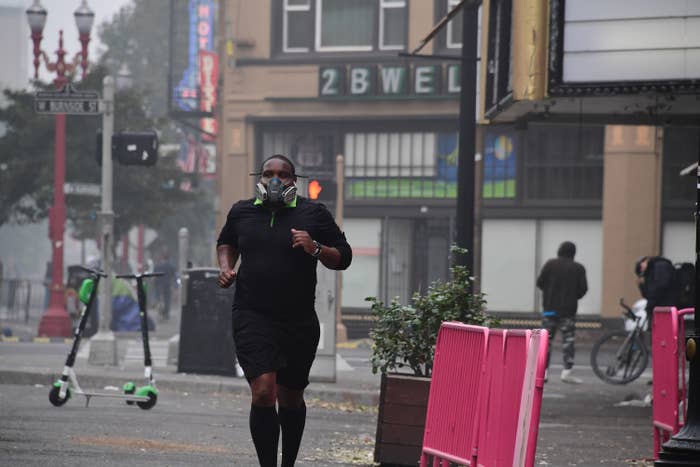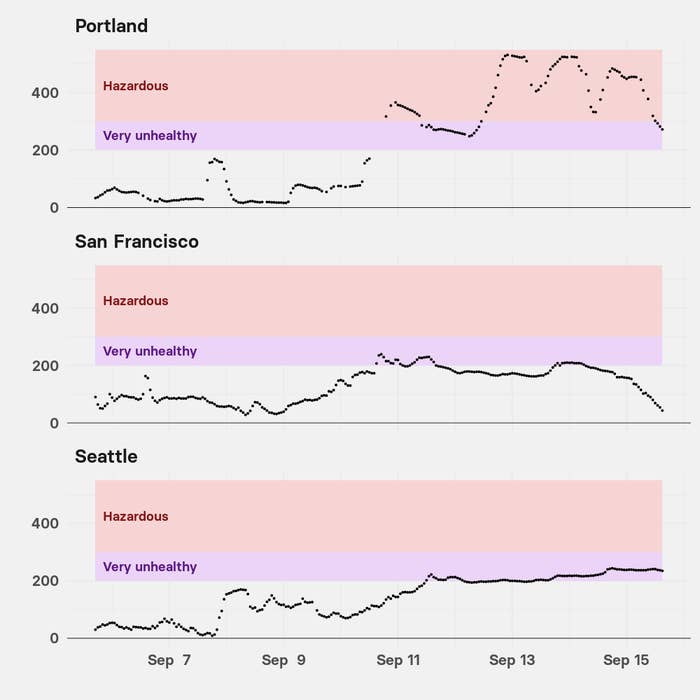
SAN FRANCISCO — Wildfires up and down the West Coast are clogging the skies with smoke and unleashing yet another health emergency upon a nation that is already in the throes of a deadly pandemic.
The historic fires made Portland, Seattle, and Vancouver the most polluted major cities in the world as of Tuesday, according to the air quality monitoring website IQAir. Delhi, the notoriously polluted Indian capital, was pushed to fourth place.
Health experts warn that, in the short term, people exposed to these high concentrations of wildfire smoke will be more likely to die of heart attacks or be hospitalized because of asthma and other respiratory problems. The longer-term effects are less clear, but early research suggests that severe exposure to wildfire smoke can cause measurable reductions in lung function that last for at least a couple of years.
Although scientists haven’t yet examined the effect of wildfire smoke on the transmission of the coronavirus, studies have already found that areas with high levels of air pollution tend to have higher rates of COVID-19 cases and deaths — even after accounting for factors like race and poverty known to be linked to higher death rates from COVID-19.
“The air quality on the West Coast is terrible,” Yifang Zhu, an environmental health sciences professor at UCLA’s Fielding School of Public Health, told BuzzFeed News. “It’s one public health crisis on top of another public health crisis.”
Air quality in major West Coast cities

This chart shows “NowCast” Air Quality Index (AQI) readings from permanent monitors in the US Environmental Protection Agency’s AirNow network, for the tiny airborne particles known as PM2.5. These pollutants are the biggest concern for health because they get deep into the lungs and are even absorbed into the blood. Anything above an AQI of 200 is considered “very unhealthy” for everyone — not just people with conditions like asthma, emphysema, and cardiovascular disease who are most sensitive to air pollution.
As wildfires raged in Oregon, Portland and other cities in the state have experienced AQIs well in excess of this level continuously since Sept. 10.
“That’s brutal,” Arden Pope, an air pollution epidemiologist at Brigham Young University in Provo, Utah, told BuzzFeed News. “Any way you look at it, all of the evidence suggests that this is a serious event, and it almost certainly is going to have substantial impacts on health.”
The extent of smoke this wildfire season is unprecedented.
“These are unheard-of high levels of particulate matter,” said John Balmes, a specialist in environmental health sciences at the University of California, San Francisco, and UC Berkeley, who is also the physician member of the California Air Resources Board. “All sorts of records have been broken in terms of poor air quality — and what is particularly alarming is this is still early in the fire season. Our worst fires the last few years have been in the fall.”
The Oregon Health Authority has already said that about one in 10 ER visits across the state right now is for asthma-like symptoms, according to Portland TV station KATU. Several studies have shown that wildfire smoke can trigger surges in hospital admissions from asthma. In one, researchers at Colorado State University found that a rise in PM2.5 concentrations of just 10 micrograms per cubic meter from wildfire smoke was associated with an 8% increase in asthma-related hospital admissions. Concentrations surged by more than 200 micrograms per cubic meter in Portland over the course of just a few hours on Sept. 10.
Severe health effects from exposure to wildfire smoke can kick in almost immediately. In a paper published in June, researchers at the University of British Columbia in Vancouver found that ambulance dispatches in the Canadian province for heart attacks, strokes, asthma, and other breathing problems increased within one hour of a rise in PM2.5 concentrations of just 10 micrograms per cubic meter.
In Delhi and other cities in northern India, AQIs similar to those seen in West Coast cities in the past few days are common and can persist for long periods. According to a 2018 study, average life expectancy across the nation is being shortened by about 1.7 years because of air pollution.
Bad as the current situation on the US West Coast is, exposures to very high levels of PM2.5 from wildfire smoke in the region’s big cities have so far been transient and relatively infrequent. The San Francisco Bay Area has been hit by multiday severe air pollution incidents in 2017, 2018, and 2020. But with wildfires getting bigger and more intense across the West with climate change, experts fear that the region may be moving into dangerous territory with bigger effects on population health.
“We’re not quite annual, but we’re getting there,” Michael Brauer, a specialist in environmental health at the University of British Columbia, told BuzzFeed News. “If you look at the predictions, it’s only going to get worse.”
One of the biggest concerns right now is that the toxic air will intensify the other major health crisis facing the region.
There is already evidence that exposure to wildfire smoke can make people more susceptible to the seasonal flu, caused by another respiratory virus. In Montana, higher daily PM2.5 concentrations during the summer wildfire season have been linked to higher rates of influenza in the following flu season.
It makes sense that wildfire smoke would make people more vulnerable to infection by respiratory viruses because PM2.5 particles damage cells called alveolar macrophages, which are an important line of immune defense in air sacs deep in the lungs. “If the alveolar macrophages are overloaded with toxic particles, whether those particles are from tobacco smoke, marijuana smoke, vaping, or wildfire smoke, they don’t function as well,” Balmes said.
One glimmer of hope is that both the pandemic and the wildfire smoke are making people stay at home, which should decrease both exposure to PM2.5 and the likelihood of spreading the coronavirus. For those who need to venture outside in order to work, the best protection is N95 masks, not the cloth masks worn to reduce transmission of the virus.
Those forced to flee their homes in the face of the advancing flames are in an especially vulnerable situation.
“If people are able to safely shelter in place, we could see reductions in transmission,” Sheryl Magzamen, an environmental epidemiologist at Colorado State University, told BuzzFeed News. “But we know that Oregon is experiencing massive evacuations and loss of shelter.”
She added, “We are in uncharted territory here, both because of COVID and because of the intensity and duration of the wildfires.”


